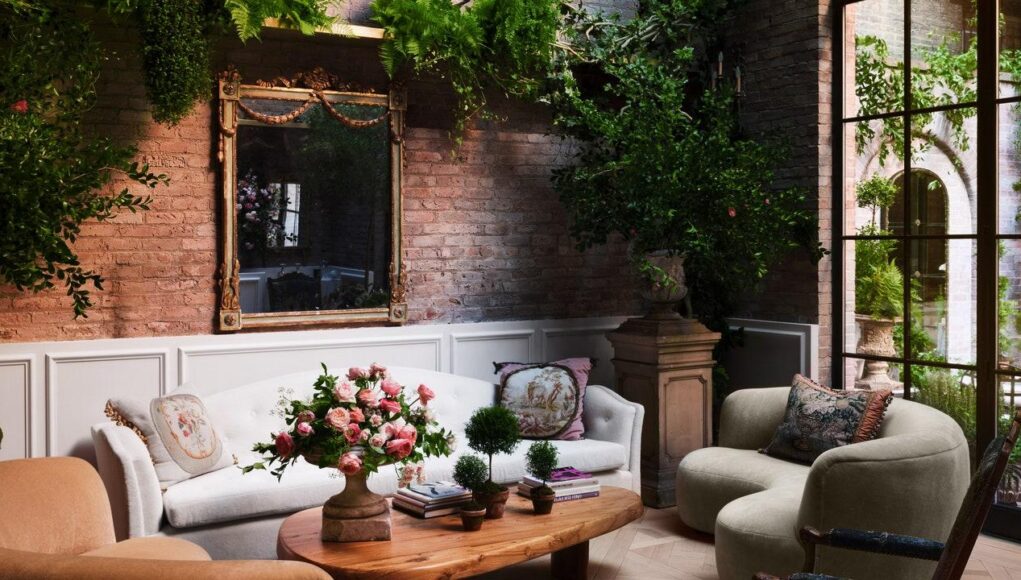As the name suggests, carriage houses originated as spaces on a property constructed to contain a horse and carriage. The popularity of the outbuildings coincided with the rise of horse-drawn carriages in 18th-century Great Britain, where they became a class signifier for the wealthy, who then had reason to establish a space for storing the vehicle, animal, and all the attendant equipment. Often, carriage houses shared the same design aesthetic as the main building on the grounds, and some even came with their own modest living quarters or lofts for the horse groomsmen. Many of these edifices currently function as ADUs, though others have been fully converted into bright, well-appointed spaces that a horse and groomsmen would likely have been thrilled to occupy. And despite their association with the countryside life, plenty of carriage houses are situated in cities—like Taylor Swift’s famous New York rental, the locale after which her song “Cornelia Street” was named. Read on for a selection of carriage houses creatively reimagined from their horse-and-buggy days to suit their residents’ modern tastes.
A 19th-Century Manhattan Jewel Box
John and Christine Gachot, the husband-and-wife team behind AD100 firm Gachot studio, will be the first to tell you they’re always up for a good challenge—especially one that, as Christine says, allows them to “flex a different muscle.” And they’ve done just that with their most recent undertaking: A renovation of a mid-19th-century carriage house on one of New York City’s picturesque mews.
Tucked away on Manhattan’s East Side, the single-family pied-à-terre is every bit as quaint as its locale, but at the start of the project, it was in much need of a contemporary update. “I think it was last renovated in the eighties or nineties,” John says.
After owning the 1,700-square-foot residence for several years, the clients tapped Gachot Studios to help them with the project. “The main thing we wanted, apart from a complete refresh, was to introduce color into what was a very beige ’90s palette,” the homeowners said via email.
And therein lay the challenge.
John and Christine decided to take a multilayered approach: one that was sensitive to the home’s history, and imaginative in its use of color. “We wanted to respect this historic little jewel box,” Christine says. The pair restored the original details, such as the crown molding and baseboards, while infusing the space with a modern aesthetic through custom-designed furnishings, textured wall coverings, and the client’s own blue-chip art collection filled with works by Antony Gormley, Wolfgang Tillmans, and Emil Nolde, among other artists. —Nicole Anderson
An Industrial Boston Abode
Boston’s intimate Beacon Hill is home to carriage houses that date to the 1800s (most, on cobbled streets that sparkle with gas lamps). This one, featuring design from LTK Interiors’ Lisa Kreiling, has been modernized for its relaxed residents. Still, it continues to embrace its historic bones in its decorative choices, which are smart and understated. “I was thinking ‘stable’ with some wood planking, some regular tongue and groove,” says Kreiling. “It’s rich and elegant with dark, mixed-width boards—but, not farmhouse.”
Remodeling this historic home demanded creativity and grace. (Remember, carriage houses were constructed for carriages and horses.) “Because they were more functional in nature, many of these carriage houses have quirkier design elements,” the homeowner says. These—including, odd-shaped windows, staircases in unconventional places, and wide floorboards—have naturally invited more creative interior design elements. “Our carriage house was designed to capture the essence of a functional carriage house, combined with an industrial feel and a sense of Europe and the Middle East, which are areas that we travel to very often.”
The first floor—which is where the carriages would have been housed—has been transformed from dim to luminous. This is the result of inspired choices, like the creation of light sources: for example, the ceiling hatch in the entertainment room, which guides sun from the second floor. “We like the floor cutout between the first and second floors because it integrates the house—and our family—in a creative way while bringing light through from the skylight down to the first floor,” the homeowner says. In the rooms on the first floor, the marine-like hues (including Benjamin Moore’s Philipsburg Blue and Farrow & Ball’s Mole’s Breath) are meant to echo the colors of Boston’s Charles River. —Elizabeth Quinn Brown
A Victorian Carriage House in New Orleans
Dusty pink with forest green accents is an unconventional colorway for the façade of a house. But when it came to a New Orleans Victorian renovation, those are just the hues that Samantha Wetton and Alexandra Neu of Los Angeles–based Lafayette Studio decided were best. “We were driving around town, looking at other people’s color combinations and trying to come up with our favorite,” explains Wetton, as she talks about the property they renovated for a retired Southern California couple moving to the quiet neighborhood to be closer to their daughter and son-in-law. In a place like New Orleans, where vibrant architecture is a visible language, their choice “speaks to the playfulness the city has to offer,” Wetton says.
Their desire to embrace the essence of the city continues inside. After a series of unfortunate decorating efforts in the 1980s and ’90s left the 1904 structure with terra-cotta tiled kitchen countertops, colored bathtubs, and carpets the color of spoiled avocado, the designers wanted to restore the dignity of the house while honoring its original era. “I envisioned all the ways in which we could bring it back to its potential, because it still had a lot of its architectural bones,” Wetton says. “They were just hidden by all of these bad renovations over time.”
Although many of the home’s pieces were brought into the city, much of its look and feel come courtesy of local salvage yards, antique shops, and craftspeople. “A big part of our design process was trying to highlight local artisans and makers,” Wetton says, referencing contributions by the likes of Chip Martinson. “Our overall design intent was to preserve the historical shell and details of the home,” Wetton says. Neu adds: “[On] all the projects we work, we want [them] to feel like there’s a history, and [they’ve] been lived in. I think we did a pretty good job.” —Michelle Duncan
A Kennedy Compound Cottage
The undertaking was almost daunting enough to deter Amy and former Rhode Island congressman Patrick Kennedy—son of the late Senator Edward “Ted” Kennedy—from even taking on the renovation of the 1904 Hyannis Port “garage” that had fallen to them. But the desire to give their burgeoning brood of kids the same idyllic summertime experiences Patrick had grown up with overruled any hesitations.
Vivid images of the famed Kennedy compound are emblazoned in the eyes of several generations: Marine One landing on the lawn for weekends President John F. Kennedy spent with his brothers; cousins running toward the helicopter to greet their fathers. Patrick wasn’t born yet, but he speaks of it as if he remembers. But for one of the most iconic bloodlines in America, the approach to design is far from flashy. Amy and Patrick repurposed much of what was inside the dusty inherited former carriage house of the residence his Irish Catholic grandfather Joseph P. Kennedy Sr., with wife Rose Kennedy, purchased in 1928, “principally because they weren’t allowed to join any other community,” says Patrick of the place they famously raised their nine children. ”What my wife, Amy, did was transform what was frankly a garage into a home,” says Patrick of the year-and-a-half-long renovation.
Their thrifty, respectful renovation is an approach that must be genetic, since Patrick recalls knowing “it was never about the big house, the ornate architecture. The house was just a location. My grandparents were obviously very, very wealthy, but they never, ironically, invested a lot building out a really fancy house,” he says. “They were never trying to impress anyone. It’s very understated. [Our house] is a very glorified bunkhouse, a crash pad that has very nice architectural aesthetics.”
The crash pad definition rang true throughout the cottage’s history, since it was where the Kennedy boys—John, Robert, and Edward among them—hid out when they came in too late. Now the nautically inspired abode sleeps the couple and their five children quite cozily, thanks to a conscientious design that makes much better use of its 2,000-square-foot footprint than when it was a four-bay garage with a two-bedroom apartment on top. That was the biggest challenge, says Amy, who has a design business and played with the floor plan before collaborating with the “very creative” builder to find space in every nook and roofline.—Kathryn Romeyn
A Fashion Designer’s Historic Manhattan Dwelling
This year, Rebecca Hessel Cohen celebrates 10 years since she launched her ultrafeminine super-maximalist clothing and lifestyle business, LoveShackFancy. Frilly and floral, the hugely popular brand is a wildly unabashed ode to romanticism in a current design environment that so often equates elegance with minimalism and great taste with 50 shades of wan. It should come as no surprise, then, that when she and her husband, Todd Cohen (also her business partner), took on a West Village town house renovation for their family over five years ago, their adventure was nothing short of an epic love story filled with passion, indulgence, and obsession. One need only consider the home’s 154 antique decorative light fixtures to understand the monumental scope of it all.
The couple, both native New Yorkers from the Upper East Side, had been renting a town house, as new parents, in the neighborhood for a few years when they came across their dream home. “It was a total shell,” recalls Hessel Cohen. “But when I first walked through it and then out to the carriage house in the back—which was the most magnificent thing I’ve ever seen in New York City—I was like, ‘I don’t know what we need to do, but we need to grab this house.’”
Grab they did, and Cohen soon started in on the renovations. “I had built new buildings before,” he says, noting that he develops real estate in addition to working alongside his wife. “But I’d never done anything of this scale—for my loved ones. I didn’t realize how intense it all would be.” On his immediate to-do list: Connect the carriage house to the main structure, install a new staircase, and create a new basement. “The house dates from the late 1800s,” he says, “so you just had to have the nerve to go through with all those changes.” —Ariel Foxman
A Renowned Artist’s Colorful Brooklyn Abode
When the artist Jorge Pardo decided to move his studio from Los Angeles to the Yucatán nine years ago, it made sense to transfer his American home base east to New York. The city was a short hop from Cancún and a place where he could easily connect with galleries and visit his daughter, Penelope, who had recently relocated there. Looking to imprint his original and exuberantly colored vision, he landed on an early 1900s carriage house nestled between a low-rise apartment building and a garage in Bushwick, a Brooklyn neighborhood that has so far resisted full-scale gentrification.
“I’m an immigrant, and this was an immigrant community I really liked,” says Pardo, a Cuban American who grew up in Chicago from the age of six. “It’s Latin, with people selling food on the street and little cell-phone-fixing stores,” not to mention a Popeyes chicken, his beloved Starbucks, and the L train close at hand. It reminds him, he says, of East L.A., where he lived happily for many years after enrolling at Art Center College of Design in the ’80s. —Eve MacSweeney








